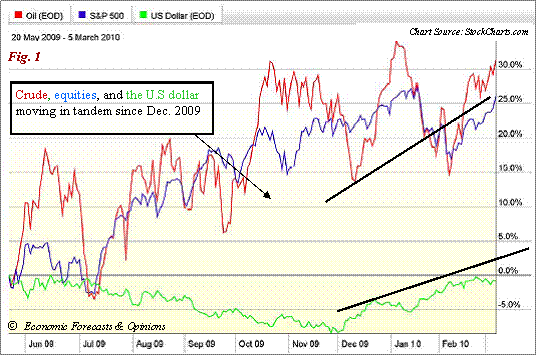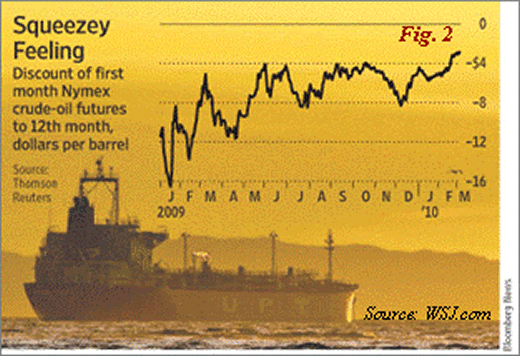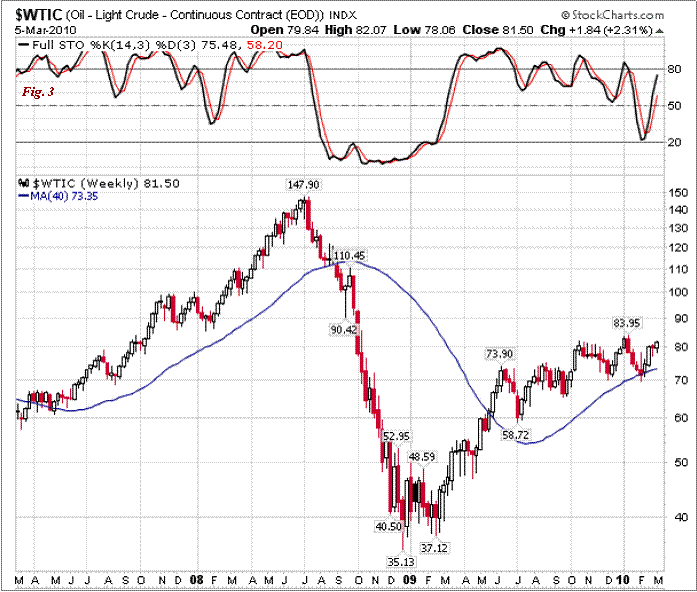Crude Oil Breaks The Dollar Rule For The Summer High Noon
Commodities / Crude Oil Mar 08, 2010 - 04:08 AM GMTBy: Dian_L_Chu
 Crude oil surged to its highest level in almost eight weeks and gasoline also rose to a 17-month high after the U.S. employment declined less than forecast in February. Encouraged by the upbeat news, investors moved into oil on the expectation that fuel demand will climb as economic growth picks up pace.
Crude oil surged to its highest level in almost eight weeks and gasoline also rose to a 17-month high after the U.S. employment declined less than forecast in February. Encouraged by the upbeat news, investors moved into oil on the expectation that fuel demand will climb as economic growth picks up pace.
Extending the impressive gains of 9.3% in February, crude oil for April delivery settled at $81.50 a barrel on the New York Mercantile Exchange (NYMEX), the highest closing price since Jan. 11. The contract jumped 2.3% in last week alone.
Positive statements from China that it would maintain its economic stimulus, rekindling hopes for accelerating growth to drain excess oil supplies also helped support the oil market.
Moving On Up Via Currency?
New York crude has been trading in the $69-$83 range since late September as uncertainty over the global economy has contributed to several failed rallies. The close above $81, capping a 14.5% increase from a year-to-date low last month, sparked speculation that oil could be targeting $85 in the near term.
Now, some traders and analysts say currency movements may play an important role in pushing prices beyond those limits.... or will they?
Breaking The Dollar Rule
Much of the movement in oil over the past year was driven by overall fund flows out of the U.S. dollar as opposed to supply and demand fundamentals of the commodity. Dollar weakness tends to boost dollar-denominated commodities, which has characterized the relationship between crude and the dollar for most of last year. (Fig. 1)

However, just as the Greece debt crisis negatively impacted the euro pushing gold and the US dollar to trade in tandem (see analysis), the dollar’s no longer in the driver’s seat dictating the direction of crude prices, as crude and the dollar have both advanced since last December. (Fig. 1)
This break in the pattern suggests this year could be a transition where broader market fundamentals begin to take hold, with weekly inventory levels and demand trends becoming a larger factor for the energy market.
Down The Contango Spread
Meanwhile, the forward curve has flattened out considerably. The spread between the near-month oil in relation to the 12-month forward contract has dropped from $8.32 per barrel three months ago to the current level of around $2.50 per barrel (Fig. 2).

Tanked The Floating Storage
This narrowing of the contango spread is reflected in the tankers market as well. Since storing oil has actually become less lucrative in recent months, estimates show that floating inventories have been falling just as demand picks up.
Though the floating storage data is sketchy at best, Bloomberg reported the number of tankers used as floating storage for crude oil and diesel fell 20% in January, based on a Feb. 8 report from Simpson, Spence & Young Ltd., the world’s second- largest shipbroker.
Meanwhile, figures presented by Gibson showed 112 ships were storing crude oil and clean products globally by February, down from a high of 149 ships at the end of November.
As for the number of barrels, recently Goldman Sachs calculated that total stored hydrocarbons at sea, including barrels in transit, fell to 636 million barrels in January versus 660 million barrels the previous month. Whereas Research firm JBC Energy estimates some 40 million barrels of middle distillates, such as diesel, stored at sea had been drawn by the end of February. That leaves another 60 million or so still floating out there.
Strong Buy Side Sentiment
Crude oil prices have also moved in very close unison to stocks and economic sentiment for the last year or so (Fig. 1). It seems investors appear ready to call the worst over as equity investors and oil speculators have both been diving into buying mode.
The disclosure that China’s sovereign wealth fund was the fourth-largest investor in the US Oil exchange traded fund (USO), and the spat between Argentina and Great Britain over oil drilling near the Falkland Islands add only additional enthusiasm to an already bullish market psyche.
Buying interest in riskier assets, including oil, should only pick up with more positive economic data coming forward.
Riding Into The Summer High Noon
The latest weekly data showed U.S. inventories of crude oil climbed to their highest level since August and are still 5.7% above the five-year average. But traders said the market may be ignoring the inventory build because more than half of it occurred in PADD 5 on the U.S. West Coast, where the distribution system is isolated from the rest of the country.
Nevertheless, refinery operating rates climbed to almost 82% at the end of February, the highest level since October, bolstering demand, while total average fuel demand over the past four weeks was up 3% from a year earlier, according to the U.S. Energy Information Administration (EIA) report on March 3.
The EIA now expects the crude oil market to strengthen again this spring with West Texas Intermediate (WTI) rising to an average of about $81 per barrel over the second half of this year and $84 per barrel in 2011.
JPMorgan Chase & Co. (JPM) also raised its 2010 forecast for crude oil partly because of reduced inventories in floating storage. JPMorgan now expects WTI crude oil to average $83.50 a barrel this year, up from their previous forecast of $78.25. JPMorgan also increased its outlook for global oil demand by 110,000 barrels a day to 86.3 million barrels a day.
With the summer driving season coming into play, this demand-side pressure should give impetus to higher oil prices over the next 4 months.
Technically Speaking
The new development of settling above $81 on NYMEX has left the commodity sitting just below its 2010 high of $83.93. A break above this price point will trigger some buying pressure, and will initiate the next leg up to around the $87.00 levels. A decisive clearance of that level will put the commodity on the path to further upside gains toward the key psychological level at $95.00. (Fig. 3)

On any pullback, the Feb. 22 high of $80.75 is expected to provide the next level of support, thus turning crude oil back up again. If this level of support fails, crude should find support at the Feb. 25 low of $77.02.
OPEC Puts Floor at $75
The Organization of Petroleum Exporting Countries (OPEC) is scheduled to meet in Vienna on March 17. Saudi Arabia’s King Abdullah has targeted $75 a barrel as a fair price for consumers and producers. This suggests $75 to be essentially the floor that OPEC would defend.
Oil prices should continue to rise during the summer driving season with the yearly high established near the July 4th holiday. After that, many factors will have to be weighed such as, the Federal Reserve Policy, inflation concerns, the unemployment rate, consumer sentiment, global growth, and geo-political issues.
Furthermore, with paper currencies all over the globe losing their value, commodities such as oil will remain an investment favorite with major capital inflows over the next 5 years.
"Cycles of shortage and surplus characterize the entire history of oil." ~ Daniel Yergin
Dian L. Chu, M.B.A., C.P.M. and Chartered Economist, is a market analyst and financial writer regularly contributing to Seeking Alpha, Zero Hedge, and other major investment websites. Ms. Chu has been syndicated to Reuters, USA Today, NPR, and BusinessWeek. She blogs at Economic Forecasts & Opinions.
© 2010 Copyright Dian L. Chu - All Rights Reserved Disclaimer: The above is a matter of opinion provided for general information purposes only and is not intended as investment advice. Information and analysis above are derived from sources and utilising methods believed to be reliable, but we cannot accept responsibility for any losses you may incur as a result of this analysis. Individuals should consult with their personal financial advisors.
© 2005-2022 http://www.MarketOracle.co.uk - The Market Oracle is a FREE Daily Financial Markets Analysis & Forecasting online publication.



